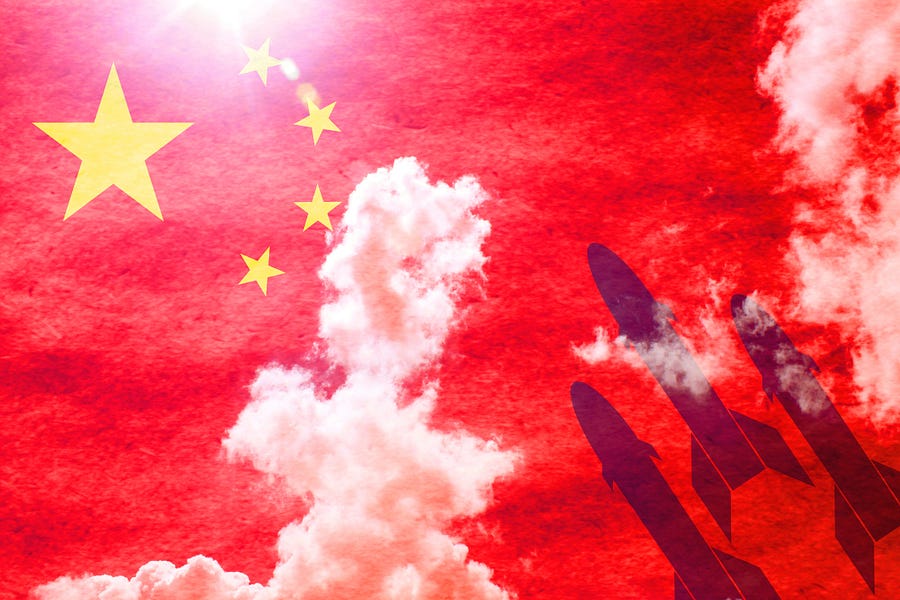This weekend, the Financial Times reported that, back in August, China successfully tested a nuclear-capable hypersonic missile that went into space and orbited the globe before reentering earth’s atmosphere and landing within a couple dozen miles of its intended target. The article’s authors, Demetri Sevastopulo and Kathrin Hille, also claim American intelligence agencies were “surprised” by the test and that it “showed that China had made astounding progress on hypersonic weapons and was far more advanced than U.S. officials realized.”
Now nerds like me are all speculating about the implications of this development. What does this capability mean for the balance of power between the United States and China? Are the two nations now officially in a “cold war?” Are U.S. companies and technologies assisting China’s military rise? And, why were our intelligence agencies “surprised?”
I’ll take each of these questions in turn.
First, the capability that China demonstrated in August is not unique, but it is important. The United States, Russia, China, and other nations have been researching hypersonic missiles for quite some time. The United States has been pursuing these weapons since at least the early 2000s—with the Pentagon seeking to spend nearly $4 billion on hypersonic R&D in 2022. In 2019 Russia said it had already deployed a regiment of hypersonic nuclear-capable missiles. Likewise, American officials have known that Beijing is pursuing hypersonics and putting real money into these efforts. But apparently, we did not appreciate the progress of these programs (more on that later).
The appeal of hypersonics is that they are more likely to overcome strategic missile defense systems and to hit their targets with very little warning. While nuclear-armed intercontinental ballistic missiles (ICBMS) actually fly faster than hypersonic missiles (about 15,000 miles per hour versus 3,600 mph), ICBMS have to fly a parabolic trajectory that is relatively easy to predict and to intercept. Hypersonic “glide vehicles” like the one tested by the Chinese, however, are able to maneuver and change their flight path while still going very, very fast. This makes them much more difficult to detect, to predict, and to intercept. Strap a thermonuclear warhead to one of these things and you’ve got a very serious problem.
There is now reason to believe that China may actually be leading the U.S. in the development of these weapons. While hypersonics are not the only way that China could deliver a nuclear warhead, they are a formidable threat in and of themselves and a potent reminder the American military superiority is not inevitable.
This, then, leads to the second question about a possible new “cold war.”
Importantly, this is not a technical term. The “Cold War” simply refers to U.S.-Soviet tensions between roughly 1945 and 1991. It’s called a cold war because the two superpowers were not openly, directly in a shooting (or “hot”) war, but were instead locked in a series of confrontations and low-level conflicts over 46 years. While tensions between the U.S. and China have not reached these same heights, there is good reason to believe they are following a similar path.
A growing consensus believes Western efforts to encourage democratic reforms in China through greater economic engagement has failed. Even more, there is broader recognition that China’s civil-military fusion and coercive economic, social, and political policies are becoming a direct threat to American citizens and interests.
There remains a great deal of debate regarding whether or not the United States should view China as an ascendant power that seeks to displace us, or as a peaking power that is already beginning its inevitable decline. Both views, though, argue that China is a growing military threat in the next five to 20 years—either because it may believe itself to be militarily superior to the United States or because it senses that its opportunity to expand its influence is narrowing and must therefore secure whatever gains that it can, while it can.
Whether you want to call this a “cold war” or not, the clear reality is that the United States and China are assuming increasingly adversarial postures toward one another, and this is driving a new technological and military arms race. Which brings us to our third question.
Shortly after the Financial Times published its story, Wisconsin GOP Rep. Mike Gallagher, who is on the House Armed Services Committee, issued this statement:
We know from a recent Washington Post report that Phytium (a Chinese company thought to be the maker of the nation’s hypersonic missiles) uses US-derived technology to power a military supercomputer that models hypersonic flight … As a result, US-derived technology produced by TSMC [a Taiwan-based semiconductor company that uses American cutting-edge chip designs] still enables Phytium’s malign work. This needs to change … American entities have a clear choice: they can side with our country, or they can side with the genocidal communist regime that now threatens our cities. They can’t do both. It is time to choose.
While most U.S. companies would never admit to directly helping the Chinese military to imperil U.S. interests, the truth is that many are doing just that.
As I have argued previously, Beijing’s near-total control of public and private research and data within its own borders—including every bit and byte of data generated by Western companies operating in China—means that the Chinese military is able to leverage this information for its own ends. Microsoft’s Beijing-based Research Asia Lab, for example, is the company’s largest outside of the U.S. and is credited as being “the single most important institution in the birth and growth of the Chinese AI ecosystem over the past two decades.”
I, therefore, tend to agree with Rep. Gallagher: It is time for U.S. companies to choose a flag.
The fourth and final question is perhaps the most comprehensively concerning. This is the question about how the U.S. intelligence community (IC) could have been surprised by China’s hypersonic program.
The Financial Times reporting doesn’t make clear what specifically surprised the IC but, unfortunately, we ought not be surprised by this surprise.
Thirteen years ago, more than 300 top-tier national security professionals and scholars worked together on the Project on National Security Reform (PNSR), producing a 700-page report assessing the U.S.’s national security capabilities and institutions, and making several hundred specific recommendations for change. The commission’s findings were arresting and they were not hidden by bureaucratic language. Here are the first two paragraphs of their executive summary:
We, twenty-two members of the Guiding Coalition of the Project on National Security Reform, affirm unanimously that the national security of the United States of America is fundamentally at risk. The U.S. position of world leadership, our country’s prosperity and priceless freedoms, and the safety of our people are challenged not only by a profusion of new and unpredictable threats, but by the now undeniable fact that the national security system of the United States is increasingly misaligned with the rapidly changing global security environment.
The legacy structures and processes of a national security system that is now more than 60 years old no longer help American leaders to formulate coherent national strategy. They do not enable them to integrate America’s hard and soft power to achieve policy goals. They prevent them from matching resources to objectives, and from planning rationally and effectively for future contingencies. As presently constituted, too, these structures and processes lack the means to detect and remedy their own deficiencies (emphasis added).
This devastating assessment, read in the context of intelligence and leadership failures like 9/11, the invasion of Iraq, the rapid downfall of the Afghan government, and now this launch of a Chinese nuclear-capable hypersonic missile, just to name a few, is, as the PNSR authors say, “undeniable.”
As a 15-year veteran of the U.S. IC, I have nothing but respect for my former colleagues. They are among the most dedicated, intelligent, and patriotic Americans our nation can produce. Nevertheless, talent and determination does not always overcome institutional decay and inefficiency, and there is now a clear record of failure that demands reform.
Most of the intellectual work for such reform has already been done by the PNSR, the Cyberspace Solarium Commission, the National Security Commission on Artificial Intelligence, and multiple other distinguished bodies. It is now largely a matter of political will and execution—two things that have been lacking for decades.
In the final analysis, then, the August launch of a Chinese nuclear-capable hypersonic missile is not transformative in a technological sense. But we can hope that we will one day look back on this development as the moment when the United States transformed itself into a nation that is truly prepared to confront a growing threat from an increasingly hostile and capable China.
Check out Klon Kitchen’s newsletter, The Kitchen Sync, on Substack.
Klon Kitchen is a senior fellow at the American Enterprise Institute, a former national security adviser to Sen. Ben Sasse (R-Neb.), and a 15-year veteran of the U.S. intelligence community. Follow him on Twitter @klonkitchen.







Please note that we at The Dispatch hold ourselves, our work, and our commenters to a higher standard than other places on the internet. We welcome comments that foster genuine debate or discussion—including comments critical of us or our work—but responses that include ad hominem attacks on fellow Dispatch members or are intended to stoke fear and anger may be moderated.
With your membership, you only have the ability to comment on The Morning Dispatch articles. Consider upgrading to join the conversation everywhere.